New Perspectives Beethoven Septet & Louise Farrenc Nonet

$100 Provides rehearsal caffeine and cookies
$250 Flies a cello with its cellist to a concert
$300 Purchases a facsimile edition of our music
$400 Pays for the editing and preparation of parts
$500 Supports a Young Mannheim Symphonist
$1,000 Helps us engage a specialist HIP musician
$2,500 Supports the creation of an education kit

$3,000 Hires a fortepiano
$5,000 Sponsors the chair of a principal musician
$10,000 Supports the work of our artistic directors
New Perspectives
Beethoven Septet & Louise Farrenc Nonet
Members of the Australian Romantic & Classical Orchestra
Georgia Browne flute | Tatjana Zimre oboe
Nicole van Bruggen clarinet | Anneke Scott horn
Lisa Goldberg bassoon | Jenna Sherry violin
Stephen King viola | Daniel Yeadon cello
Rob Nairn double bass
Ludwig van Beethoven (1770–1827)
Septet in E flat major, Op.20 (1799)
Adagio – Allegro con brio
Adagio cantabile
Tempo di menuetto – Trio
Tema con variazioni (Andante)
Scherzo (Allegro molto e vivace) – Trio
Andante con moto alla Marcia – Presto
INTERVAL
Louise Farrenc (1804–1875)
Nonet in E flat major, Op.38 (1849)
Adagio – Allegro
Andante con moto – Allegretto
Scherzo (Vivace)
Adagio – Allegro
This concert will last approximately 1 hour and 40 minutes, including a 20-minute interval.
Castle Hill | 30 May
Anglicare Castle Hill
Kenthurst | 31 May
The Hills Grammar School
Sydney | 2 June
The Neilson, ACO Pier 2/3
Brisbane | 3 June
Brisbane City Hall
Caloundra | 4 June
The Events Centre
Canberra | 6 June
Albert Hall
Newcastle | 7 June
Adamstown Uniting Church
Melbourne | 10 June
David Li Sound Gallery
Monash University
Live streamed on Australian
Digital Concert Hall
Joining us for Voyage of Musical Discovery?
BEGIN YOUR JOURNEY ON PAGE 15
“The Australian Romantic & Classical Orchestra delivers . . . with splendid playing, a unique sound and winning repertoire.”
Limelight
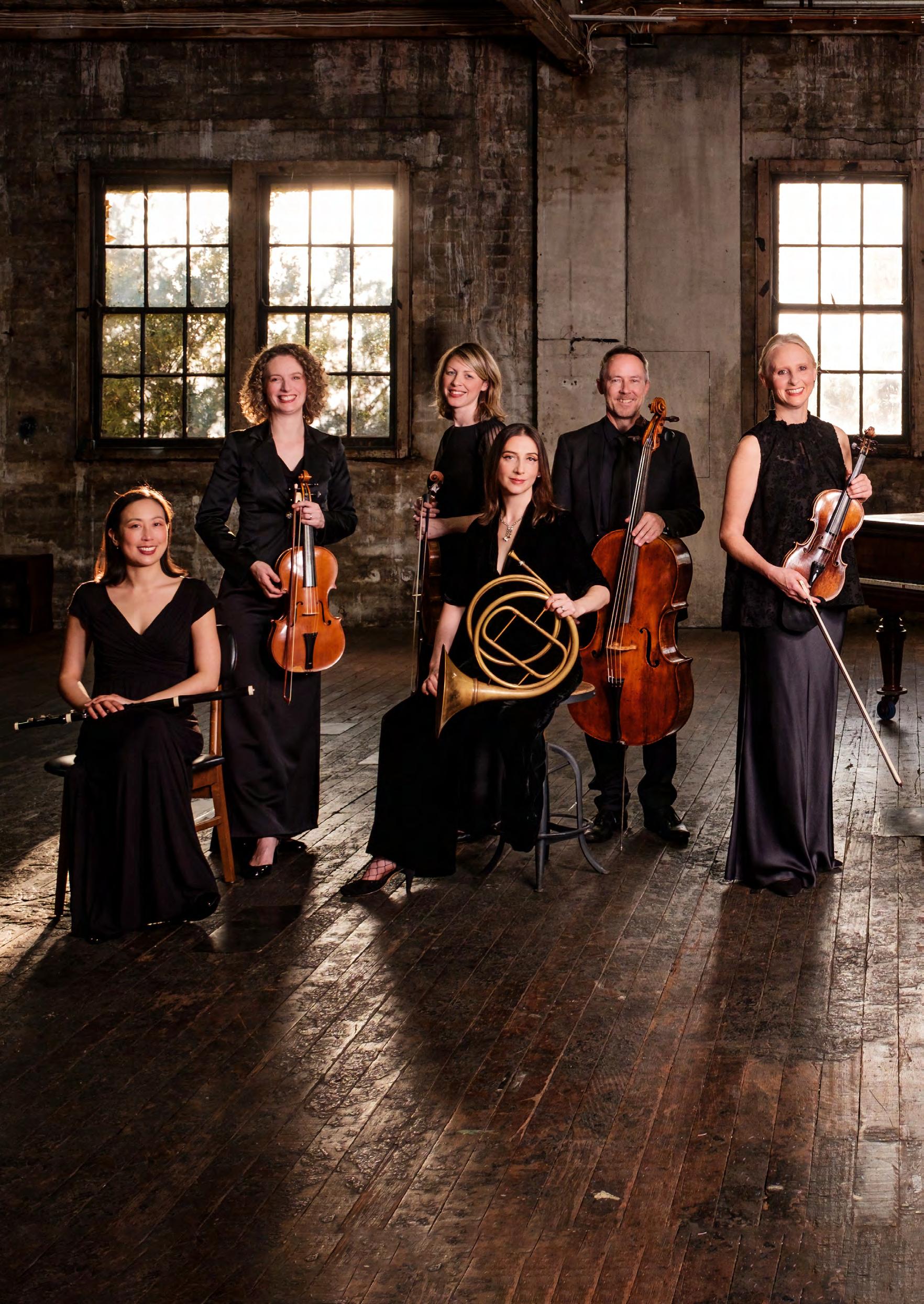

Beethoven’s Septet and Farrenc’s Nonet: Eight Decades in Vienna and Paris
Ludwig van Beethoven moves from Bonn to Vienna, arriving just before his 22nd birthday.
Beethoven completes his Septet in 1799; it receives its public premiere in 1800 and is published the following year. It will become wildly popular.
Beethoven arranges the Septet as a Trio for his doctor in 1803; this version is published as his Op.38 in 1805.
Louis Spohr composes his Grand Nonet in F major, Op.41.

Clarinettist Ferdinand Troyer commissions Franz Schubert to write an Octet for mixed ensemble, using Beethoven’s Septet as a close model.
Beethoven dies 26 March. When his possessions are auctioned, the original manuscript of his Missa Solemnis is sold for just 7 florins; the Septet goes for 18 florins.
The Paris Conservatoire is established and the first concerts of the Société des Concerts du Conservatoire are given in 1801.
Jean-Louise Dumont is born 31 May to a family of artists and shows early promise as a pianist.
Anton Reicha moves from Vienna to Paris, where he composes 25 wind quintets. Louise will study composition with Reicha from 1819 to 1825.
Spohr brings his Nonet to Paris.
Aristide wins the publishing rights for Johann Nepomuk Hummel, who becomes a family friend.
Beethoven’s Septet is extremely popular in Paris during these decades; there’s scarely a year when it doesn’t appear in the Société des Concerts programming, often more than once.
Farrenc is appointed Professor of Piano at the Paris Conservatoire.
Farrenc previews her new Nonet in December 1849; in April, Georges Onslow had introduced his own Nonet. Farrenc’s Nonet is premiered on 19 March 1850; that same year her campaign for equal pay at the Conservatoire finally succeeds.
The Farrencs’ daughter, Victorine, dies, aged 32.
Farrenc is awarded the Prix Chartier for her chamber music.
Farrenc receives the Prix Chartier a second time.
Farrenc retires from the Conservatoire. Farrenc dies 15 September.
AUSTRALIAN ROMANTIC & CLASSICAL ORCHESTRA
1795 1792 1800 1799 1805 1813 1824 1827 1804 1808 1825 1842 1849 1850 1859 1861 1869 1873 1875
1821 1820
Louise marries Aristide Farrenc, a flautist and music publisher.
1810 1830 1840 1860 1870
Edgar Degas’ painting The Orchestra at the Opera (c.1870) includes Victor Gouffé, the double bassist who played the premiere of Farrenc’s Nonet.
TOP NOTES
New Perspectives
Historically informed performance is more than historical instruments. It relies on a foundation of scholarship and creative imagination, and in most cases, the HIP specialist has had to set aside assumptions and unlearn musical habits deeply engrained since childhood. It’s a process that continually brings new perspectives, casting fresh light on the music and how it might be shared with an audience.
But what about those of us in the audience? We can’t bring historical ears to the concert. Nor can we “unhear” a lifetime of music. Even so, sometimes we too must set aside assumptions and unlearn engrained habits.
Take our expectations of the modern concert, for example, with its conventions of silence, stillness, and not applauding between movements. These are at odds with the tradition from which both works on this program emerged: the serenade or divertimento – music for diversion.
Beethoven’s models for his Septet (by Mozart) were functional music, composed for social occasions to give pleasure and create ambience. Musicians would march into place while playing, movements might be excerpted or played in brackets during the evening. And reverent silence was simply not on the cards, even among attentive listeners:
Count Salern…understands the music – he was always saying bravo, whereas the other cavaliers were taking pinches of tobacco, blowing their noses, clearing
their throats or beginning a conversation...
Mozart to his father
Beethoven, we can assume, did intend for us to listen. The “previews” for his Septet might have taken place in a private palace and a restaurant, but he introduced the work to the Viennese public in a grand benefit concert at the Imperial-Royal National Court Theatre, alongside his first symphony, one of his piano concertos and other concert music. It’s still possible, however, to recognise the Septet’s divertimento origins: in its many movements, the use of a “serenade quartet” (with double bass), the cadenza for the violinist, the pair of minuets, and the tiny march that begins the finale.
Written 50 years later, Louise Farrenc’s Nonet belongs to a different concert environment – one that seems closer to our own. By the mid-19th century, audiences were taking their concertgoing very seriously, and programs were often curated with didactic or elevating goals in mind.
That shift is reflected in the structure of the Nonet: no longer many diverting movements but instead four movements that suggest a symphony in miniature. Farrenc’s larger mixed ensemble also contributes to the symphonic character, with representatives from nearly all the sections of a (classical) orchestra. But even so, the tell-tale signs of the work’s divertimento origins are present.
The Septet and Nonet have much in common but are separated by half a
NEW PERSPECTIVES | PAGE 7
century and by very different national sensibilities: on the one hand the AustroGerman reverence for instrumental music, on the other the Parisian preference for opera and the voice over classically minded chamber music.
Henri Blanchard, reviewing the 1849 premiere of Farrenc’s Symphony No.3 in G minor, accused the Société des Concerts programmers of being “ungallant” in pairing it with Beethoven’s Fifth: opposing two symphonies, both in minor mode and both with dazzling and grandiose finales, thereby forcing listeners to compare them. (He does go on to give Farrenc’s symphony a
Ludwig van Beethoven
Septet in E flat major, op.2o
Popularity has its downside. Stravinsky fretted over the fact that his early ballet
The Firebird was so much more popular than his later works. Samuel Barber must at times have wished he’d never written a certain Adagio. And so with Beethoven. At first he’d been pleased with the success of his Opus 20 Septet, but 16 years later, when a friend told him how wildly popular this agreeable music was in England, Beethoven had replied: “That’s damned stuff. I wish it were burned!” Beethoven had decided he “didn’t know how to compose” back then; he’d moved on. Meanwhile, conservative critics were wishing he’d write more music like it.
The Septet, completed in 1799, belongs to the tradition of the Austrian divertimento. One of its first performances was planned for the palace of Prince Schwarzenberg; the
very favourable write-up.) What would Blanchard say of our gallantry – placing Beethoven’s Septet alongside Farrenc’s Nonet? We can turn to the composers themselves for reassurance. Beethoven would have dismissed his Septet as not in the same league as his Fifth Symphony – there was nothing daunting about it. Farrenc frequently programmed Beethoven alongside her own music, including some of his most challenging late works – she was clearly not to be intimidated. And maybe the Sociétè’s programmers weren’t being ungallant so much as paying Farrenc the highest compliment, as do we.
first verified performance (20 December 1799) took place in a small hall attached to a restaurant operated by the court caterer Ignaz Jahn. These contexts called for music that would delight rather than challenge, and an important clue to the Septet’s character lies in its structure: six relatively short movements, including a pair of “minuets” – dance music.
The ensemble mixes strings (violin, viola, cello and a double bass forming a “serenade quartet”) with clarinet, horn and bassoon. Remarkably, Beethoven named all seven musicians on the advertising handbill for the public premiere on 2 April 1800 – this Septet brings together individual virtuosos, giving each a congenial part to play, and for his violinist, Ignaz Schuppanzigh, Beethoven wrote a cadenza in the finale.
Playing with classical conventions in delightful and inventive ways, Beethoven
AUSTRALIAN ROMANTIC & CLASSICAL ORCHESTRA
commands attention with the solemn introductory Adagio before shifting to the lively Allegro con brio section of his first movement. The serene second movement (Adagio cantabile) gives the lead to the clarinet in a lyrical dialogue with the violin. The third movement introduces a playful take on the graceful dance rhythms of the minuet, and pianists might recognise the opening motif of Beethoven’s Sonata Op.49 No.2.
The colourful variations of the fourth movement are based on what might have been a folksong, although even Beethoven’s contemporaries were dubious about this. The song in question, “Ach Schiffer, lieber Schiffer”, didn’t appear in print until many years later, so perhaps, like the Largo from Dvořák’s New World Symphony, it was turned into a folk song after the fact.
The fifth movement points to where Beethoven would take the minuet in the 19th century: speeded up to become a boisterous Scherzo. The horn takes the spotlight with characteristic hunting calls; the cello is taken to the top of its range.

The finale begins with a march – a sombre allusion to the practice of playing outdoors and on the move – but it quickly merges into a swirling Presto (as fast as possible) with the surprise violin solo adding to the joyous spirit. Beethoven might have resented the fact, but it’s no wonder the Septet became one of his most enduringly popular works and remained a fixture in the concerts of Louise Farrenc’s Paris 50 years later.
Louise Farrenc Nonet in E flat major, op.38
Louise Farrenc is an intriguing figure for many reasons. It was not unusual to be a virtuoso pianist, composer, teacher and scholar in 19th-century Paris, but Farrenc was a trailblazer. In 1842 she was the first woman be appointed Professor of Piano at the Paris Conservatoire, remaining there until her retirement in 1873, and despite never being permitted to teach men, she successfully campaigned for parity of pay with her male colleagues.
It’s generally agreed that the acclaim surrounding the premiere of her Nonet in 1850 was influential in her finally winning over the director of the Conservatoire. But she was already a well regarded composer by that point, with three symphonies and many chamber works to her name, and while critics – including Robert Schumann and Hector Berlioz –may have expressed surprise at the quality of her compositions, their praise
NEW PERSPECTIVES | PAGE 9
Engraved portrait of the young Beethoven (Th. and August Weger after a drawing by Gandolph Ernst Stainhauser, 1801)
was nonetheless genuine and often effusive in the recognition of her talent and craft. These are all things that have become well known as Louise Farrenc’s reputation has been rekindled over the past 40 years.

What’s less well known is that Farrenc was also a "HIP" pioneer. Today, the classical music world could be charged with being more interested in old music than new. This was not always the case. Mozart arranging Bach and Handel, Mendelssohn reviving the Matthew Passion, Moscheles playing Scarlatti on a harpsichord – these were quirky endeavours. In 1830s Paris, the critic François-Joseph Fétis inaugurated a series of “historical concerts” with a survey of opera from Caccini to Weber. In the 1860s, Louise and her husband Aristide collaborated on their own contribution to the revival of old music and historical practices with Le Trésor des pianistes (The Treasure of Pianists, a massive, chronological anthology of keyboard music and performance style), and by organising concerts that tapped into the growing craze for what might best be described as lecture-recitals.
Farrenc’s professorship gave access to the leading musicians of Paris and, as with Beethoven’s Septet, performances of her Nonet were announced with all nine performers named. The public premiere of the Nonet on 19 March 1850 was especially remarkable for two reasons: it took place in the Salle Érard (a kind of Wigmore Hall) rather than a private salon, and it featured a visiting celebrity, violinist Joseph Joachim.
The extensive review in the Revue et gazette musical de Paris emphasised the Nonet’s lofty seriousness and
its composer’s disdain for the “easy success” of “frivolous compositions”. This work is not so much a diversion as an “intimate symphony”. The most obvious sign is the four-movement structure: two fast movements (Allegro), each with a solemn introduction (Adagio), frame an Andante with variations and an enigmatic Scherzo, striking for its use of plucked strings.
But the influence of Beethoven’s Septet is evident, too. There’s a violin cadenza in the surging first movement, and the theme and variations movement is a nod to the equivalent movement in the Septet – it’s even in the same key. Meanwhile, the overall tone of the Nonet is carefree, with graceful and elegant melodies, imaginative deployment of instrumental colours, and the “verve, wit and originality” for which Farrenc was praised.
AUSTRALIAN ROMANTIC & CLASSICAL ORCHESTRA
Yvonne Frindle © 2023
REPRODUCED COURTESY DR
Luigi Rubio’s portrait of Louise Farrenc, painted in 1835
CHRISTIN HEITMANN
The Mystery of Classical Playing
It might seem self-evident now that Western art music should go by the name of “classical”, a word rich in subtle references to Classical Antiquity and social class – and from there to timelessness and perfection. In the first half of the 19th century, however, these were live metaphors that came to shape all aspects of the musical tradition we have inherited.
Of special interest for historical performers is evidence of a classical playing style, increasingly praised in concert reviews from the 1830s onward, with references to perfection, spiritual elevation, transcendence, and a more than a dash of Romantic Hellenism. When the violinist Joseph Joachim (1831–1907) performed the Beethoven Violin Concerto in 1853, the reviewer for the Süddeutscher Musik-Zeitung pronounced it “classicity from the first bow stroke to the last; not a classicity that flirts with form, nay, one that is ‘in spirit and in truth’”. An 1857 review in the Neue Zeitschrift für Musik of the violinist Edmund Singer (1830–1912) characterised his performance style as “calm and classical, as one applies this expression to the art of the ancient Greeks, a sculptural quality firmly applied from the boldest to the finest.” Clara Schumann’s performance of a Beethoven

piano sonata in 1854 led Franz Liszt, in a remarkable essay on her playing, to depict her as a severe Delphic priestess.1 Henri Blanchard, reviewing a piano recital by Louise Farrenc for the Revue et Gazette Musicale in 1843, strikes similar notes, linking the word “classical” (classique) with her cultivation and severity as a performer and her elegance and purity as a composer.
The historical performance movement has in many ways rebelled against this inherited classicism. A period-instrument performance of Beethoven does not present an idealised sculpture but a living man, with moods and quirks, sometimes sublime and sometimes
1 Liszt’s review, “Clara Schumann”, published in the Neue Zeitschrift für Musik (1 December 1854), is discussed in depth by Alexander Stefaniak in “Clara Schumann and the Imagined Revelation of Musical Works”, Music and Letters, v. 99, Issue 2 (May 2018): 194–223, especially in relation to the various feminine archetypes that were applied to Clara Schumann at different points in her career.
NEW PERSPECTIVES | PAGE 11
DEEP
DIVE
Violinist Joseph Joachim performing with Clara Schumann (Pastel drawing by Adolph von Menzel, 1854)

AUSTRALIAN ROMANTIC & CLASSICAL ORCHESTRA
YALE CENTER FOR BRITISH ART B1979.14.500
“The last of a classic school” – caricature of Joseph Joachim by Leslie Matthew ‘Spy’ Ward for Vanity Fair (5 January 1905)
downright flippant. As the movement turns its attention to later repertoire, however, we are increasingly confronted with the paradox of 19th-century “classical” playing. On the one hand, the critical reception of musicians such as Joseph Joachim, Clara Schumann, Edmund Singer, and Louise Farrenc points to exactly the text-reverence and expressive austerity that we are now determined to shake loose from classical music. On the other hand, the tiny handful of recordings we have by the celebrated “classical” musicians –including some by Joachim himself –reveals a style that is anything but austere. In the case of Joachim, there are nuances of bowing and fingering, shades of articulation and emphasis, and layers of timing and pacing, none of which are obvious either from the written notation or from his priestly public image. It’s almost jazzy.
To today’s conservatory-trained ears, Joachim’s playing sounds chaotic at first – not because there is no pattern to his playing, but because his playing follows a pattern that has since been lost. Joachim’s teaching method, Violinschule, co-written with his student Andreas Moser in 1902, remarks that this highly nuanced, speechlike style
of string playing, by then stereotyped as “German”, had once been an international language, which the Germans had learned from the French violinists of the early 19th century, inspired in turn by older Italian singing traditions. Joachim felt that the French violinists of the early 20th century, in homogenising their use of the bow and their sense of colour and accentuation, had lost a crucial part of their heritage.

In that case, a historically informed performance of Farrenc should aim to give Joachim-style classicism back to France. If we imagine the Joachim of the 1850s – the man who’d played in the premiere of Louise Farrenc’s Nonet at the age of 18, surrounded by Parisian wind players – the familiar, ossified version of classical music melts away, revealing the grand spiritual longings that first created it.

Dr Kate Bennett Wadsworth is a cellist and gambist devoted to historical performance of all periods, with a special research interest in 19th-century performance practice.


NEW PERSPECTIVES | PAGE 13
Kate Bennett Wadsworth © 2023
Clara Schumann, Edmund Singer, Louise Farrenc and the young Joachim
Discover the magic of HIP
There are just a few spots left in this year’s Young Mannheim Symphonists Intensives, to be held in September (Melbourne) and October (Sydney).



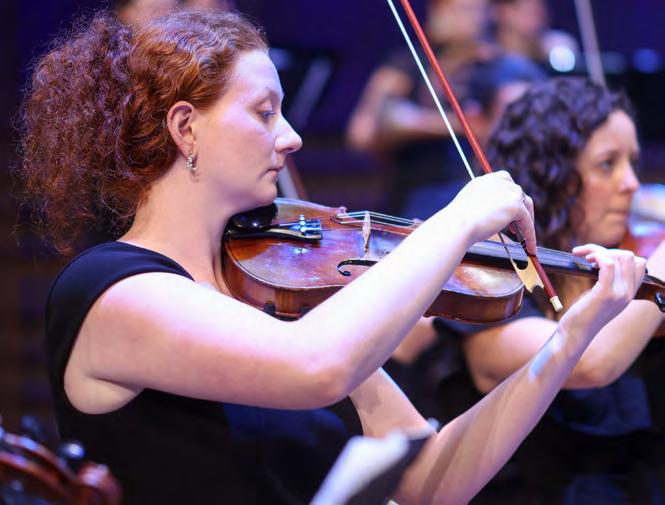
Want to join the emerging musicians who are discovering the magic of historically informed performance under the guidance of directors Rachael Beesley and Nicole van Bruggen?
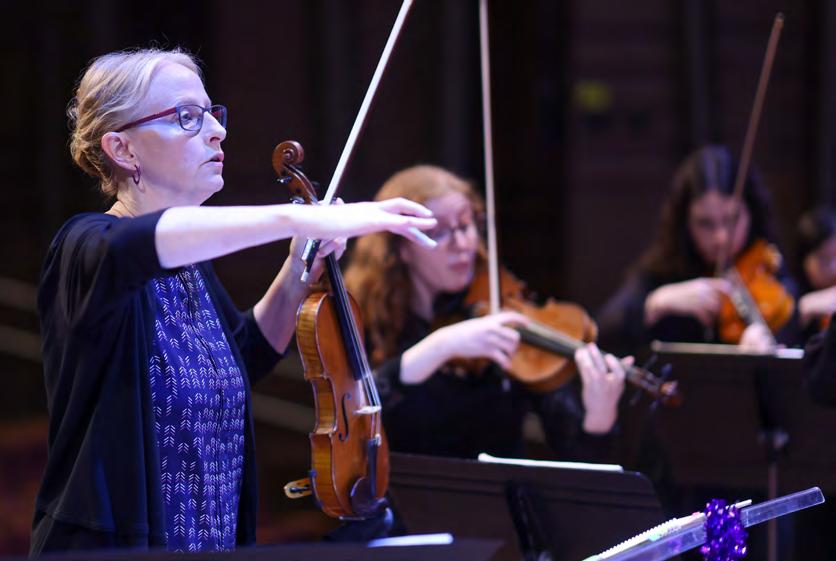
Submit your online form and audition video today!
Program
Wolfgang Amadeus MOZART
The Marriage of Figaro: Overture
Music by Carl STAMITZ, Franz RICHTER and Anton REICHA
Ludwig van BEETHOVEN
Symphony No.7 in A major, Op.92
VIC Intensive
26–30 September
Camberwell Grammar School, Melbourne
NSW Intensive
3–7 October
Conservatorium High School, Sydney
arco.org.au/yms-2023
PHOTOS: WALLIS MEDIA
APPLICATIONS CLOSE MONDAY 12 JUNE MORE INFO & APPLY ONLINE
Voyage of Musical Discovery
Cultural Narratives – Sydney
Thursday 1 June | 6.30pm The Concourse, Chatswood
Nicole van Bruggen presenter
Peter Clark presenter
Nonet in E flat major, Op.38 (1849)
by Louise Farrenc (1804–1875)
Selections from:
Adagio – Allegro
Andante con moto – Allegretto
Scherzo (Vivace)
Adagio – Allegro
Performed by members of the Australian Romantic & Classical Orchestra Turn to page 21 for their biographies
Sundried Quartet (2019, rev. 2023)
by Alice Chance (born 1994)
Exposure (Slow, still and glassy. Too bright)
Dribble Castle (With excitement)
Tomatoes (Relaxed, lazily grazing)
Aloe Vera
Performed by the Acacia Quartet
Next on the itinerary: MUSICAL IDENTITIES
31 JULY – Brisbane
03 AUGUST – Melbourne
07 AUGUST – Sydney
BOOK TODAY
The Voyage will last 90 minutes, without interval.
Alice Chance writes…
What does it mean to leave music out in the sun? Exposure is a bit like a fermentation timelapse. Beginning with translucent musical material, it slowly introduces dissonance, gradually drying and fermenting into a spicy and surprisingly tasty, crisped ending. Dribble Castle mirrors the process of building a sandcastle by dribbling wet sand into a pile. The result is an elegant structure, but the builder must be careful: one drop in the wrong place can send the castle tumbling.
While composing Tomatoes, I sat at the piano with cherry tomatoes and basil, mint, lemon juice and feta cheese. As I tasted each combination, my fingers searched for the corresponding harmony or cluster. I began writing Aloe Vera as an exhalation – a refreshing balm after the heat of the previous movements. I soon realised there was a dear friend for whom I wished this kind of reprieve and healing.
Before I knew it, a song was pouring out. I invited the first violinist to sing the secret lyrics to this song in her head as she played, letting them inform her phrasing and articulation.
VOYAGE OF
| CULTURAL
| PAGE 15
MUSICAL DISCOVERY
NARRATIVES
Voyage of Musical Discovery
Cultural Narratives – Brisbane
Monday 5 June | 11.30am
St Peters Lutheran College, Indooroopilly
Nicole van Bruggen presenter
Peter Clark presenter
Nonet in E flat major, Op.38 (1849)
by Louise Farrenc (1804–1875)
Selections from:
Adagio – Allegro
Andante con moto – Allegretto
Scherzo (Vivace)
Adagio – Allegro
Performed by members of the Australian Romantic & Classical Orchestra Turn to page 21 for their biographies
Nuevo y vivo (New and alive)
by Ignacio Varchausky and Andrés Linetzsky
Enigmático (Enigmatic)
by Julián Camilo Ferrero
Vals Sentimental (Sentimental waltz) by
Alessandra Gelfini
Como me siento (How I’m feeling)
by Owen Henry Salomé
The Thrilling Encounter by
Cécile Elton
Performed by Tango Enigmático
The Voyage will last 90 minutes, without interval.
Argentinian tango music is a living and evolving urban popular dance music tradition that continues to inspire and captivate audiences and dancers around the world.
Tango Enigmático’s presentation features original compositions by living composers, beginning with the fittingly named tango Nuevo y vivo. Their namesake work, Enigmático, is a deeply personal exploration of a crossroads in life. Vals Sentimental by Italian tango composer and pianist Alessandra Gelfini is a stunning example of the tango vals (waltz) style. Como me siento, by Australian bandoneonist and composer Owen Henry Salomé, features elements from the milonga campera (slow milonga) style and delves into the complexity of human emotion. The presentation concludes with The Thrilling Encounter – a fast-paced milonga ciudadana (city milonga) by Australian composer Cécile Elton – capturing the energy of meeting new people at tango dance events and partying with great live music.
AUSTRALIAN ROMANTIC & CLASSICAL ORCHESTRA
Voyage of Musical Discovery
Cultural Narratives – Melbourne
Thursday 8 June | 6.30pm
Alexander Theatre, Monash University
Nicole van Bruggen presenter
Peter Clark presenter
Nonet in E flat major, Op.38 (1849) by Louise Farrenc (1804–1875)
Selections from:
Adagio – Allegro
Andante con moto – Allegretto
Scherzo (Vivace)
Adagio – Allegro
Performed by members of the Australian Romantic & Classical Orchestra Turn to page 21 for their biographies
CLIMATE NOTES
Memory Rings (2021)
Kate Moore (born 1979)
Pressed (2021) by Damian Barbeler (born 1972)
How We Fell (2021) by Bree van Reyk (born 1978)
Performed by
Anna McMichael violin
Louise Devenish percussion
Climate Notes is a performance and video project by Anna McMichael and Louise Devenish that propels us to consider what it feels like to live through a time when climate change affects every aspect of our lives.
The work builds on Joe Duggan’s Is This How You Feel collections of handwritten letters from science researchers from all over the world. This emotive project includes new musical works by Australians Damien Barbeler, Daniel Blinkhorn, Dylan Crismani, Cathy Milliken, Kate Moore and Bree van Reyk, composed for varying combinations of violin and percussion, together with electronics and field recordings. Bree van Reyk’s work uses custom percussive–string instruments of her own design called Replica Trees.
Video credits: Memory Rings – Nick Roux; Pressed – video by Damien Barbeler using images from the archives of the State Botanical Collection of Victoria; How We Fell – video by Bree van Reyk.
The Voyage will last 90 minutes, without interval.
VOYAGE OF MUSICAL DISCOVERY | CULTURAL NARRATIVES | PAGE 17
Guest Voyagers
Peter Clark presenter
Based in New York City, Peter Clark has been performing as a violinist with the Australian Romantic & Classical Orchestra since 2018. In addition to presenting concerts in the Voyage of Musical Discovery program, he also tutors Young Mannheim Symphonists workshops.

As a violinist, he has performed with the Australian Chamber Orchestra (making his Carnegie Hall debut with the ACO at the age of 20), and appears regularly as concertmaster with Sydney Chamber Opera, Victorian Opera and New Zealand Opera, as well as the Darwin Symphony Orchestra. He has also performed as Principal Second Violin of the RTÉ Orchestra, Dublin, and in 2020 was appointed a principal member of the Omega Ensemble. His music presentation work reflects a commitment to arts access and education. He has performed in more than 130 regional venues across Australia and, through his work with the ACO, he developed a much-loved music outreach program at Melbourne’s Royal Children’s Hospital. He also presents pre-concert talks for many organisations, including the Sydney Symphony Orchestra. His doctoral research on social innovation and cohesion through music is generously supported by Judith Neilson am and the General Sir John Monash Foundation. He is completing an MBA in Arts Innovation, with the support of the American Australian Association.
Acacia Quartet
The Acacia Quartet was founded in 2010 by violinists Lisa Stewart and Myee Clohessy, violist Stefan Duwe and cellist Anna Martin-Scrase; Doreen Cumming joined the quartet as second violinist in 2022. The Quartet has won respect for its versatile and inventive programming, as well as its collaborations with Australian composers, work with young musicians, and its members’ commitment to sharing their love of music with audiences of all ages.
Australian engagements have included concerts at the Sydney Opera House, City Recital Hall and Melbourne Recital Hall, as well as extensive touring throughout regional NSW and Victoria. The Quartet made its international debut at Vancouver’s Roundhouse in 2016, and the following year was invited by the Christine Raphael Foundation to give its European debut, performing in Berlin and recording string quartets by Günter Raphael. In addition to featuring regularly in radio broadcasts worldwide, the Quartet has recorded 12 albums, with Blue Silence earning an Award for Excellence nomination in the APRA-AMCOS Art Music Awards. The Acacia Quartet is the Ensemble in Residence at the Orange Regional Conservatorium.

ROMANTIC
CLASSICAL
AUSTRALIAN
&
ORCHESTRA
PHOTO: ROBERT CATTO
PHOTO: HOLLY BRADFORD
Tango Enigmático
Tango Enigmático is a Brisbane-based ensemble specialising in Argentinian tango music. Its members – Chloe Ann Williamson (double bass), Cara Tran (piano) and Flora Wong (violin) – share a vision to promote tango music in Australia. By blending classics from the golden age of tango with contemporary compositions, they present this style of music as a living and evolving urban art form. Chloe has studied with Ignacio Varchausky, Juan Pablo Navarro and Pablo Aslan, and undertaken research in Buenos Aires. She twice attended Tango for Musicians at Reed College (Portland OR), on the second occasion with her ensemble, Mendoza Tango Quartet, which she directed from 2014 to 2018. She also directs the Brisbane Tango Orchestra, and is a member of Toronto’s Solidaridad Tango. In addition to working with Tango Enigmático, Flora is a member of Nonsemble, Voltfruit and Obscure Orchestra, and co-director of Dots+Loops. In 2017, she led the Momentum Ensemble in a contemporary tango program with accordionist James Crabb. Cara’s interest in the music of Piazzolla was sparked in 2016 when she performed alongside James Crabb at AYO’s National Music Camp; two years later she joined the Mendoza Tango Quartet. She is a member of Nonsemble and the Brisbane Tango Orchestra, and has toured with Ensemble Entourage for Musica Viva in Schools.

Anna McMichael violin
Louise Devenish percussion
Anna McMichael and Louise Devenish are both on the faculty of Monash University, and in 2021 they collaborated on the Climate Notes multimedia and installation project, launched last year at the Royal Botanic Gardens Victoria.

Anna won the Strings category of the ABC Instrumental and Vocal Competition before studying violin at the Royal Conservatoire in The Hague. She returned to Australia after 17 years in Europe, performing and touring extensively with leading Dutch ensembles and the London Sinfonietta. As well as appearing as a guest concertmaster with the ASO and performing with Ensemble Offspring and the Omega Ensemble, she also performs with Pinchgut Opera and Ludovico’s Band and is a core member of Ironwood.
Louise is a contemporary percussionist whose creative practice blends performance, artistic research, and creative collaboration with composers, visual artists, designers and improvisors. An advocate for new music, she has commissioned more than 50 percussion works, and she has performed throughout Australia and internationally as both a soloist and a member of such ensembles as Decibel (WA), The Sound Collectors Lab, Intercurrent and Synergy Percssion. She has recorded a solo album, music for percussion and electronics.
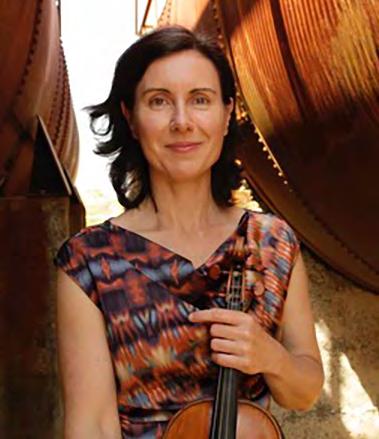
VOYAGE OF MUSICAL DISCOVERY | CULTURAL NARRATIVES | PAGE 19
PHOTO: CHRIS WARDLE
PHOTOS: S. RAYMOND, O. DAVIES
Australian Romantic & Classical Orchestra
Inspire − Educate − Enlighten
The Australian Romantic & Classical Orchestra specialises in period instrument performances of late 18th- to early 20th-century orchestral and chamber music, and is at the forefront of the historical performance (HIP) scene, staying abreast with the latest research and developments around the world by collaborating with key guest musicians and musicologists. Under the artistic direction of Rachael Beesley and Nicole van Bruggen, the orchestra has been praised for its “intelligent and warm performances, demonstrating the importance of historically informed musicianship and showcasing the impact of period instruments with gut strings” (ArtsHub, 2020).
Founded in 2012 under the artistic direction of renowned musician and educator, the late Richard Gill, the orchestra is now, in its 10th year, a dynamic influence on the Australian music scene. Its twin goals of performance and education are achieved through live concerts in Australia’s capital cities and in metropolitan and regional centres, collaborations with guest ensembles, broadcasts and recordings, innovative music education programs, pre-concert presentations and specialist online resources. Gathering together leading Australian and international exponents, the Australian Romantic & Classical Orchestra brings historical insights and new perspectives to masterpieces from the Classical and Romantic periods.
The orchestra’s unique music education series, Voyage of Musical Discovery, is presented in Sydney, Brisbane and, this year, in Melbourne for the first time. The Voyage is equal parts concert and demonstration, and features collaborations with exceptional guest musicians and ensembles to explore through words and music the compositonal similarities between historical and Australian contemporary works. The Young Mannheim Symphonists youth orchestra program gives students and emerging musicians the opportunity to discover for themselves the magic of approaching music with historical performance style.
To learn more about the Australian Romantic & Classical Orchestra’s educational activities, please visit arco.org.au/education
AUSTRALIAN ROMANTIC & CLASSICAL ORCHESTRA
Georgia Browne
flute

Georgia is an internationally recognised soloist, chamber musician, orchestral player and teacher. Performing on replica and original historical flutes, she has appeared in many exciting locations, performing with some of the world’s leading ensembles. She is principal flute with Pygmalion in France, and with the English Consort, Arcangelo, Orchestra of the Age of Enlightenment and Dunedin Consort in the UK. When she returns to Australia, she appears with the Australian Haydn Ensemble, Van Diemen’s Band, Bach Akademie Australia and the ACO. Her recordings include a celebrated album of flute music by Carl Friedrich Abel, and the most-viewed performance of CPE Bach’s Sonata in A minor on YouTube. A graduate of the Royal Conservatoire in The Hague, her own teaching profile spans four continents, and each year she hosts a residential summer school in south-west France.
Flute by Martin Wenner, Singen, Germany (2007) after August Grenser, Dresden (c.1790)
Tatjana Zimre oboe
Tatjana was born in Germany and studied oboe and violin from a young age, graduating from the Mozarteum Salzburg. She subsequently studied historical oboes at the Anton Bruckner Privatuniversität, Linz and the Conservatorium van Amsterdam. She has appeared as a soloist in festivals and concerts throughout Europe, including the Regensburger Tage für Alte Musik, Festspiele Mecklenburg-Vorpommern, Budapest Spring Festival and Musiques sur Ciel. She also performs with the Balthasar Neumann Ensemble, Orchestra of the 18th Century, Anima Eterna Brugge, Le Concert Spirituel, Le Concert Spirituel, Concerto Köln, Nederlandse Bachvereniging, Hofkapelle München, Wiener Akademie and La Folia Barockorchester, as well as Munich Baroque, an ensemble she founded with her sister Anna Zimre in 2017.

Oboe by Alberto Ponchio, Vicenza, Italy (2015) after Heinrich Grenser, Dresden, Germany (c.1790)
Nicole van Bruggen clarinet

Originally from Sydney, Nicole is a highly respected exponent of historical clarinets, appearing as principal clarinet in leading period instrument orchestras such as Concerto Copenhagen, Den Ny Opera (Denmark), Arte dei Suonatori (Poland), New Dutch Academy and the Australian Brandenburg Orchestra, as well as playing with Tafelmusik (Canada) and Les Musiciens du Louvre, and in the Utrecht Early Music Festival. She is principal clarinettist, co-artistic director and general manager for the Australian Romantic & Classical Orchestra, and is committed to music education and the promotion of historically informed performance. She studied modern clarinet at the Sydney Conservatorium before moving to The Netherlands to study historical clarinet at the Royal Conservatoire in The Hague, where she was based for 17 years.
Clarinet in B flat by Agnès Gueroult, Paris, France (2002–04) after Theodor Lotz, Vienna (c.1810)
NEW PERSPECTIVES | PAGE 21
PHOTO: GREGOR EISENMANN
PHOTO: DAVID OLDFIELD
PHOTO: NICK GILBERT
Anneke Scott horn
Anneke’s work takes her around the globe with a repertoire incorporating music and instruments from the late 17th century to the present. She is principal horn of the Orchestre Révolutionnaire et Romantique, English Baroque Soloists, Irish Baroque Orchestra, Pygmalion, The Sixteen, and Dunedin Consort and Players, and is in demand as a guest principal horn. She is frequently heard in the obbligato arias of Bach and Handel as well as baroque solo concertos, and her recordings include three albums featuring music by 19th-century Parisian horn player Jacques-François Gallay. As a chamber musician, she performs with ensembles such as Boxwood & Brass, The Prince Regent’s Band, Syrinx and ensembleF2, as well as working with keyboardists Steven Devine, Neal Peres da Costa, Geoffrey Govier and Kathryn Cok, and harpist Frances Kelly.
Horn by Andreas Jungwirth, Vienna, Austria (2012) after Johann Anton Lausmann (late 18th/early 19th century)
Lisa Goldberg bassoon
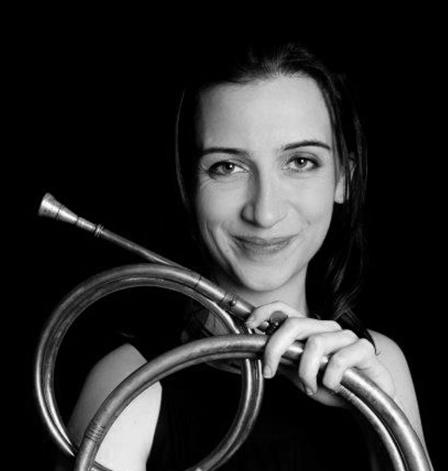


Based in Ghent, Belgium, Lisa performs on dulcian as well as baroque, classical and romantic bassoons, in a wide range of repertoire and styles. She studied modern bassoon at the Canberra School of Music, while freelancing with various Australian symphony orchestras. Following lessons on historical bassoons with Simon Rickard and performing in the Australian Brandenburg Orchestra, she received an Ian Potter grant to study with Donna Agrell at the Royal Conservatoire in The Hague. Since moving to Europe, she has appeared with Vox Luminis, Anima Eterna, Il Gardellino, Ricercar Ensemble, Collegium Vocale Gent, Il Fondamento, Red Herring, Les Musiciens du Louvre, Concerto Copenhagen, Freiburg Baroque Orchestra, Nederlandse Bach Vereniging, Gabrieli Consort, B’Rock, New Dutch Academy, Den Ny Opera and Pinchgut Opera.
Bassoon by Peter de Koningh, The Netherlands (c.1990) after JH Grenser, Dresden, Germany (c.1790)
Jenna Sherry violin
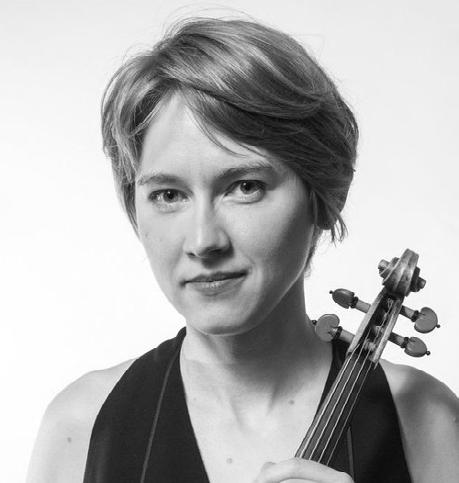
Jenna grew up in New Orleans and is now based in London, where she specialises in historical performance. Her experience ranges from the Orchestre Révolutionnaire et Romantique and English Baroque Soloists to Ensemble Experimental (SWR, Freiburg) and collaborating with composers Unsuk Chin and Julian Anderson. She has appeared at the Kennedy Center and the Barbican, and in the Aldeburgh, Salzburg Chamber Music, and Acht Brücken (Cologne) festivals, among others. In 2020 she recorded sonatas by Brahms (Op.120) and Dohnányi with pianist Dániel Lőwenberg. She also teaches violin and chamber music at the School for Young Talent in the Royal Conservatoire, The Hague, and is the founding artistic director of the Birdfoot Festival.
Violin by Joachim Schade, Germany (2015), after Stradivarius (1705); bow by Stephan Sänger (2021) after François Xavier Tourte (1780–90)
AUSTRALIAN ROMANTIC & CLASSICAL ORCHESTRA
PHOTO: FREDERIK STYNS
PHOTO: BRIDGET CAMBRIDGE
PHOTO: RYAN HODGSON-RIGSBEE
Stephen King viola
Growing up in Canberra, Stephen studied violin before falling for the darker world of the viola. He completed his studies in the USA, earning a Doctorate in Chamber Music, and while there he was a member of the Coolidge String Quartet, Associate Principal Viola of the Boston Philharmonic Orchestra and a member of the Boston Modern Orchestra Project. Since then, he has been a member of the ACO and the Australian String Quartet, as well as performing throughout Australia and worldwide. With ASQ, he developed projects with First Nations artists, commissions, and cross-artform and digital collaborations, and at the ACO he played a role in founding the Emerging Artists program and ACO2. He has been a regular guest principal with the Tasmanian Symphony Orchestra and has played with the Australian World Orchestra.

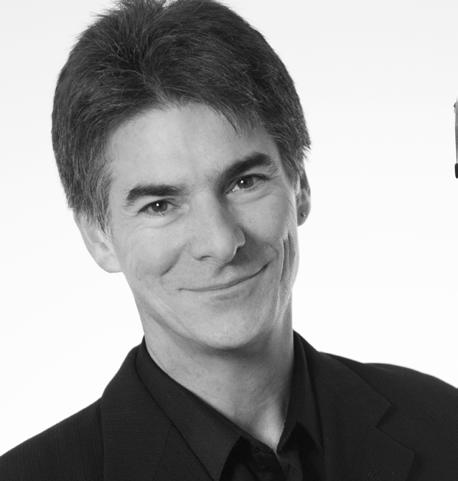
Viola by Hiroshi Iizuka, Philadelphia (1996) inspired by the viola d’amore and lira da braccio (15th–17th cent.); bow by Emilio Slaviero, Cremona (2014) after Sartory
Daniel Yeadon cello
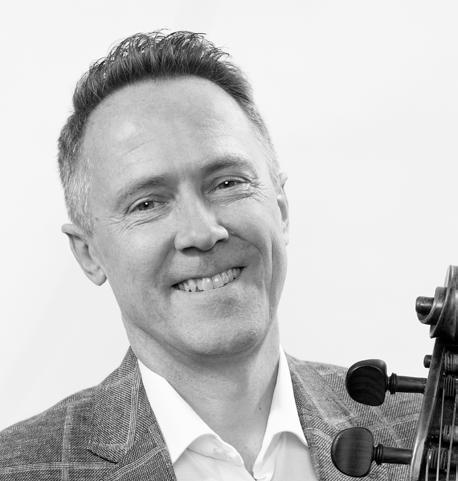
Daniel is a cellist and viola da gamba player, whose musical interests include repertoire from the Renaissance to the present day. He is a passionate chamber musician and plays regularly with the Australian Romantic & Classical Orchestra, Ironwood, Bach Akademie Australia, Australian Chamber Orchestra and Australian Haydn Ensemble. He appears courtesy of the Sydney Conservatorium of Music, where he is a lecturer in cello, chamber music and historical performance. His current research interests include 19th-century performance practices and the potential uses of sound design in science education. He is a Sydney Nano ambassador and is involved in multiple sciencemusic research collaborations. Cello by William Forster II, London, England (1781); bow by Evan Orman, Denver, USA (2006)
Rob Nairn double bass
Rob is principal bass with the Australian Brandenburg Orchestra. A specialist in historical performance, he has worked with Boston Early Music Festival, Handel+Haydn Society, Juilliard Baroque, Orchestre Révolutionnaire et Romantique, English Baroque Soloists, Concerto Caledonia, Washington Bach Consort, Rebel, Florilegium, and the Orchestra of the Age of Enlightenment, as well as with Muffat Collective, Ironwood and Adelaide Baroque. He has also played with most of the Australian and numerous international orchestras, such as the London Philharmonic Orchestra, the Pittsburgh, Oslo, Gothenburg and Bavarian Radio symphony orchestras, the Hallé, and the London Sinfonietta. Formerly head of the Early Music Department at Melbourne University, he is now Master Musician in Residence at the Elder Conservatorium.
Double bass by Joseph Xavier Jacquet, Mirecourt, France (1840); bow by James Tubbs (c.1870)
NEW PERSPECTIVES | PAGE 23
PHOTO: SYDNEY CONSERVATORIUM
PHOTO: JACQUI WAY
PHOTO: HANDEL+HAYDN SOCIETY
Supporting the Orchestra
The Australian Romantic & Classical Orchestra would not thrive without the time, treasure and talent donated by our extraordinary patrons and musicians. What began as an act of love and passion by the Australian Romantic & Classical Orchestra’s founder, the late Richard Gill, has become one of Australia’s finest orchestras, devoted to playing the rich and varied music of the Classical and Romantic eras with historical integrity while educating future generations of musicians.
We are extremely grateful to the generous individuals, families and foundations who make significant contributions to the orchestra’s performance and education activities. A combination of support from private donations, philanthropic funding, and federal and state governments is essential for the continuation of our work, and we invite you to join their ranks.
Donation Options
Join us on our journey today by making a tax-deductible donation. All gifts –whether large or small, cash or in-kind – contribute to sustaining the orchestra’s performance and education activities. To make a donation, to find out more about our Donor Circles, or to make a bequest, please visit arco.org.au/donate
Richard Gill ao Memorial Fund
The Richard Gill ao Memorial Fund was established at Richard’s request to support the objectives of the Australian Romantic & Classical Orchestra. Richard’s vision, as the orchestra's founding artistic director, was to:
• foster a love and enjoyment of historically informed performance in Australia
• make music accessible to the broadest possible audience
• educate and inspire future generations of Australian musicians. Your support will allow us to continue his legacy. Please donate by visiting arco.org.au/richard-gill-memorial-fund
Annual donations are acknowledged for 12 months following each donation.
AUSTRALIAN ROMANTIC & CLASSICAL ORCHESTRA
Acknowledgements
Annual Donors
Principal Sponsors
Paul Salteri am & Sandra Salteri
Principal Young Mannheim
Symphonists
Sponsor
Metal Manufactures
Pty Ltd
The Co-Artistic Directors’ Patrons
$10,000+
Robert Albert ao & Elizabeth Albert
Denbigh Foundation
Ian Dickson & Reg Holloway
Humanity Foundation & Talya Masel
Hedley McGregor
Robert Salzer Foundation
Anonymous
Principal Flute Chair Patrons
Ian & Pam McGaw
Principal Clarinet Chair Patron
Professor Richard Kefford am
Richard Gill ao Memorial Fund Annual Donors
$10,000–$19,999
Susie Dickson & the late Martin Dickson
$1,000–$4,999
Michael & Dimity Riley
$500–$999
Jennifer Bott ao
Kay Vernon
Margaret Wait Ferguson
$1,000–$4,999
Don Harwin
Ann McFarlane
Julianne Maxwell
Timothy Pascoe
Michael & Dimity Riley
Felicite Ross
Peter Stirling
$500–$999
Nicole van Bruggen
Michael Chesterman
Catherine Davies
Jürgen & Ailsa Eckel
Stephen Gower
Joshua Murray
Richard Spencer
Roger & Karen Stott
NEW PERSPECTIVES | PAGE 25
Behind the Scenes
BOARD
CLAIRE GILL
Chair
JASON BOWRAN
NICOLE VAN BRUGGEN
JENNIFER HOY
ELIZABETH SCOTT
OPERATIONS
NICOLE VAN BRUGGEN
General Manager
ROSEMARY PONNEKANTI
Operations & Communications Manager
STEPHEN BYDDER
Marketing Assistant
YVONNE FRINDLE
Communications Consultant
CAMERON BRYER
Social Media & Digital Coordinator
AUDIO-VISUAL
JEFFREY CHEAH
Video Producer
THOMAS GRUBB, MANO MUSICA
SOUND ON SAFARI
Audio Engineers & Producers
AUSTRALIAN DIGITAL CONCERT HALL
Livestream
PROGRAM BOOK PHOTOGRAPHY: Robert Catto
ARTISTIC
RICHARD GILL✝
Founding Artistic Director
RACHAEL BEESLEY & NICOLE VAN BRUGGEN
Co-Artistic Directors
PROF. NEAL PERES DA COSTA
Artistic Advisor
HUGH ROBERTSON
Digital Marketing Consultant
CHARLES MACINNES
Voyage Education Kit Author
SIRMAI ARTS MARKETING
Publicist
JOSH MURRAY DESIGN
Designer
ROBERT CATTO
HIKARI PHOTOGRAPHY
WALLIS MEDIA
PETER HISLOP
Photographers
AUSTRALIAN ROMANTIC & CLASSICAL ORCHESTRA
Government Partners


Young Mannheim Symphonists Sponsor






Media Partners

Program Partners

NEW PERSPECTIVES | PAGE 27
LUTHERAN COLLEGE
JULY–AUGUST
Midsummer Dreams
Australian Romantic & Classical Orchestra
Rachael Beesley conductor
MENDELSSOHN A Midsummer Night’s Dream Overture
BEETHOVEN Symphony No.8
MENDELSSOHN Symphony No.3, Scottish
Sunday 30 July | 3.00pm
Brisbane City Hall
Tuesday 1 August | 7.00pm
Albert Hall, Canberra
Friday 4 August | 7.00pm
Monash University, Melbourne
Saturday 5 August | 7.00pm
Newcastle City Hall (NSW)
Sunday 6 August | 3.00pm
The Joan, Penrith, Sydney
Tuesday 8 August | 7.00pm
The Concourse, Chatswood, Sydney
VOYAGE OF MUSICAL DISCOVERY
Musical Identities
Monday 31 July | 11.30am
St Peter’s Lutheran College, Brisbane
Thursday 3 August | 6.30pm
Monash University, Melbourne
Monday 7 August | 6.30pm
City Recital Hall, Sydney












































